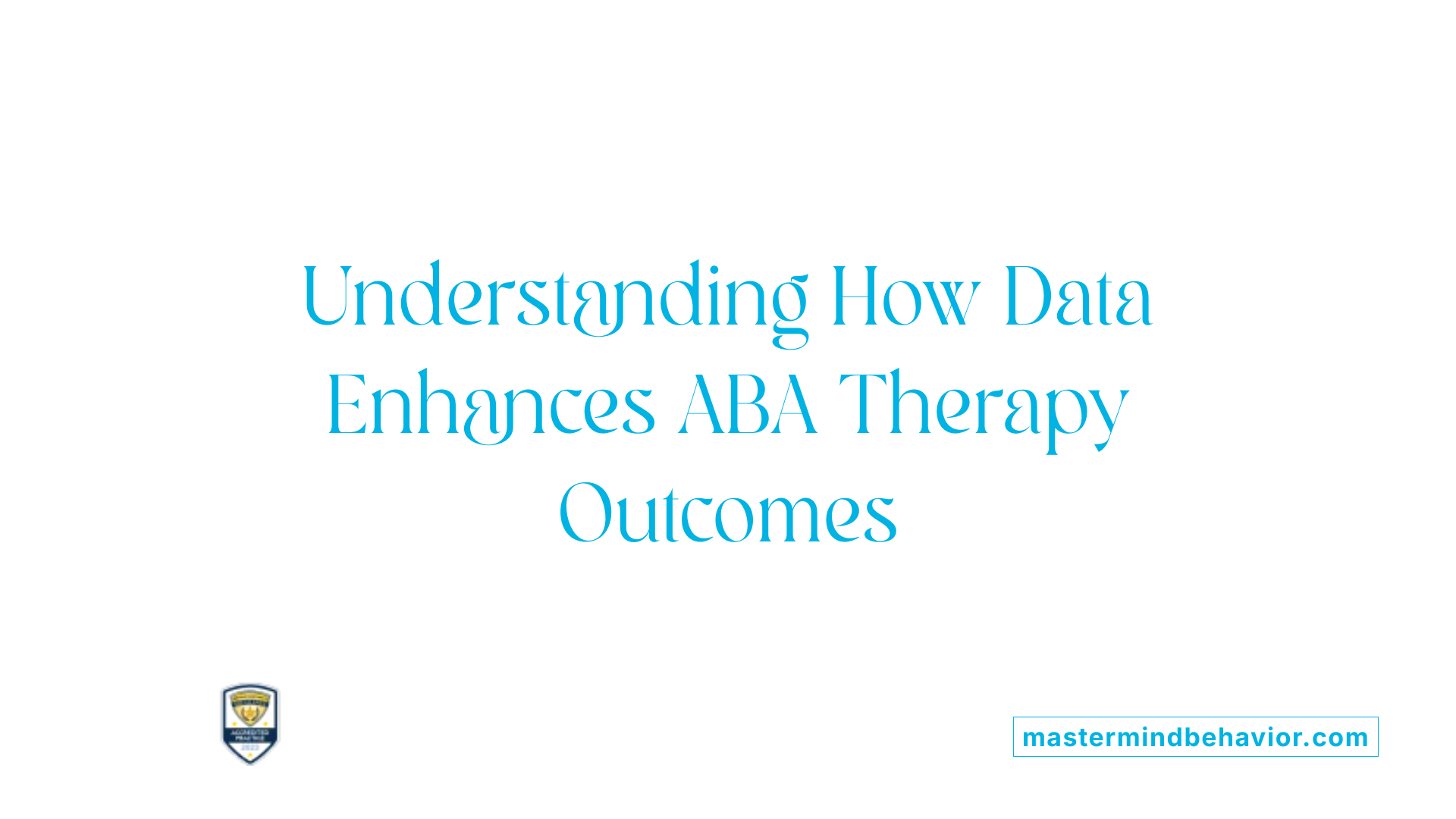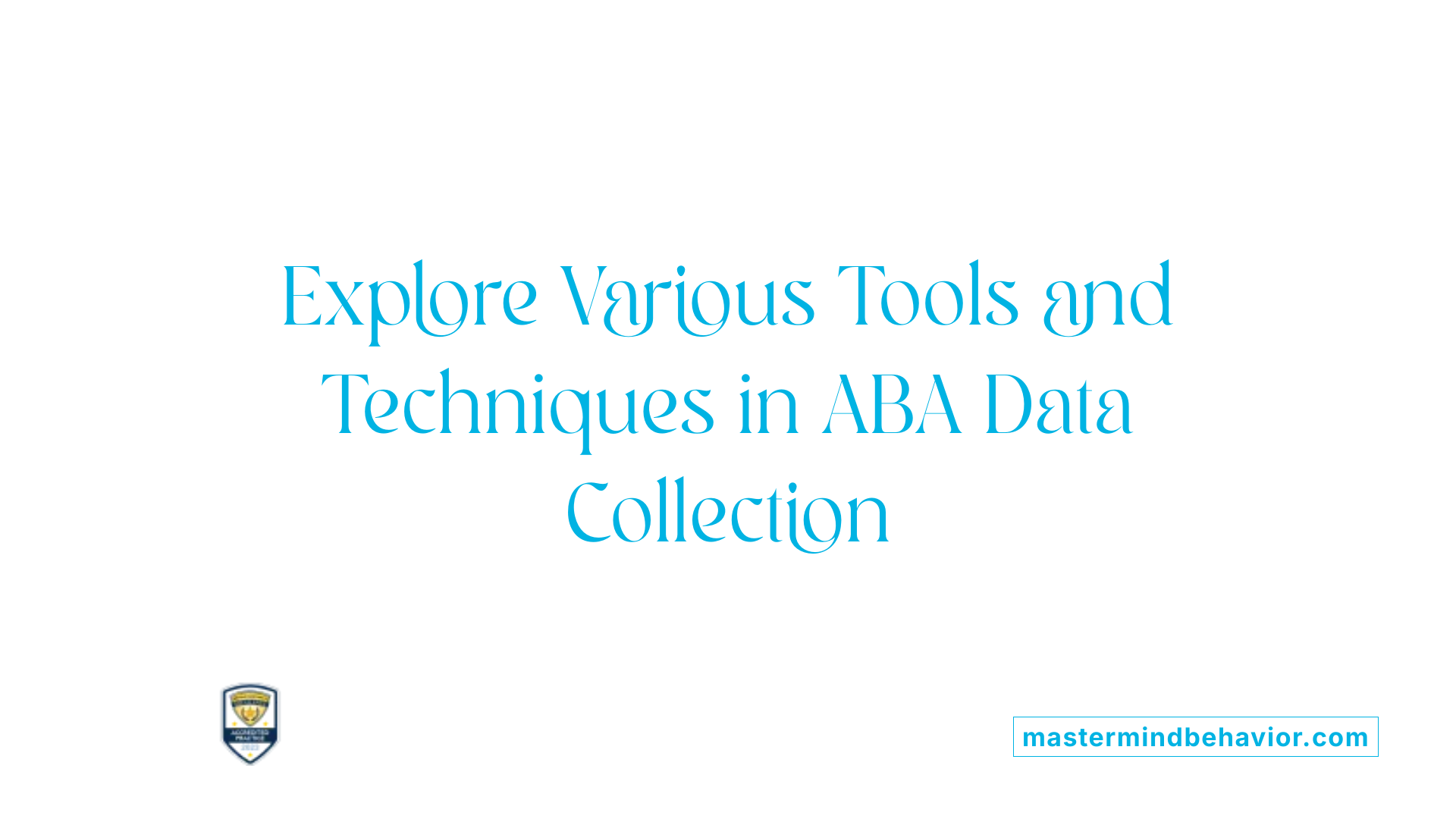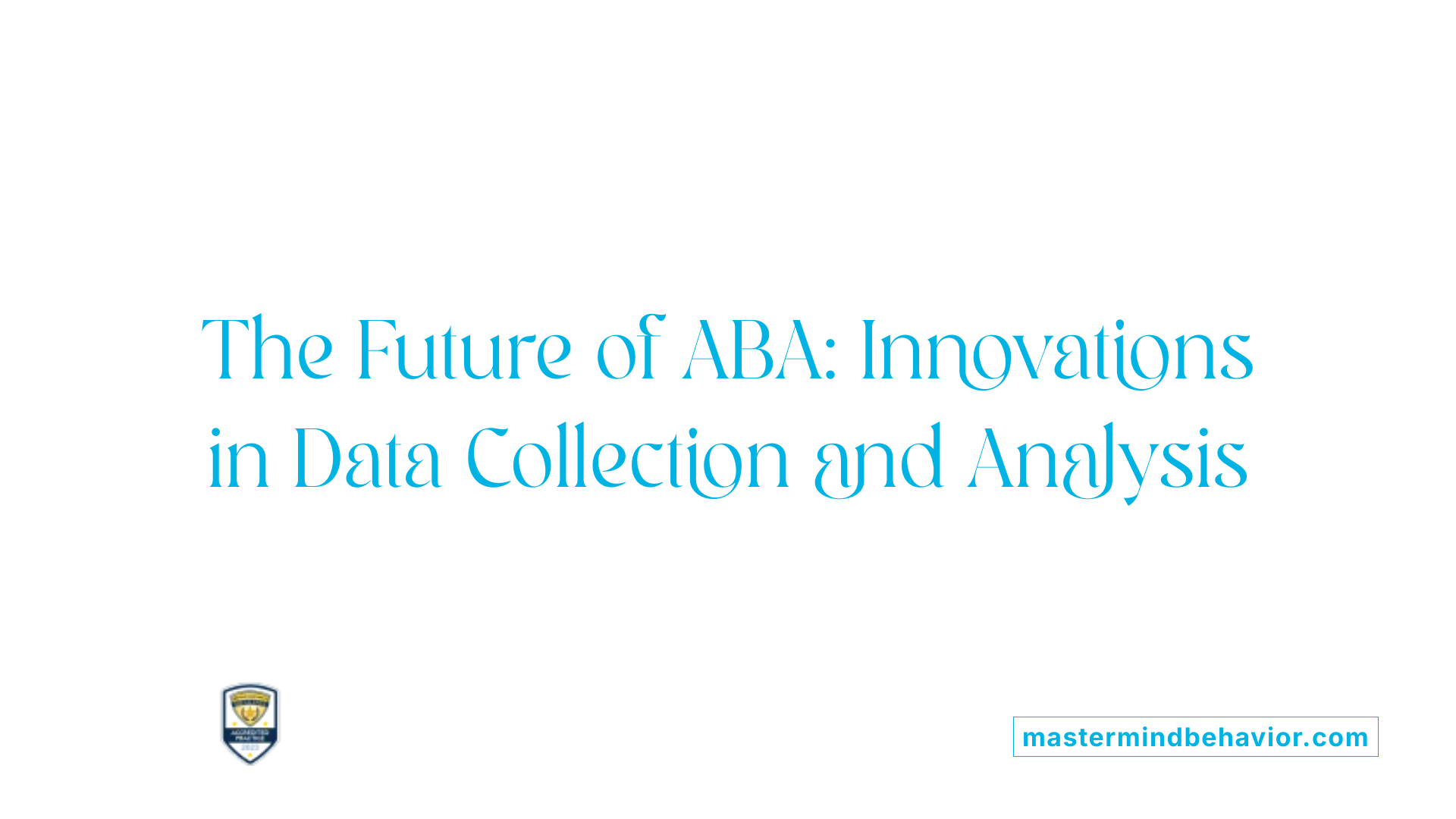The role of data collection in ABA therapy

Understanding the Critical Role of Data Collection in ABA
Applied Behavior Analysis (ABA) therapy is a highly structured, evidence-based approach that relies fundamentally on the systematic collection and analysis of data. Accurate and consistent data collection empowers therapists to develop, implement, and refine individualized treatment plans that promote meaningful progress for children with developmental and behavioral challenges. This article delves into the importance of data collection, the methods employed, technological advancements, and the ethical considerations underpinning responsible practice in ABA.
Significance of Data Collection in ABA Therapy
Why is data collection important in ABA therapy?
Data collection plays a crucial role in applied behavior analysis (ABA) therapy because it provides an objective foundation for tailoring effective interventions. By systematically recording behaviors and environmental factors—such as how often a behavior occurs, how long it lasts, or the specific antecedents and consequences—therapists gain a clear understanding of each child's unique patterns and triggers. This detailed information enables practitioners to design highly personalized strategies that target specific behaviors or skill areas.
Consistent data collection also allows for ongoing monitoring of progress. When therapists regularly analyze recorded data, they can identify trends, assess whether interventions are working, and make timely modifications to optimize outcomes. This approach ensures that treatment remains responsive to the child's evolving needs.
Moreover, precise documentation fosters transparency and accountability. Sharing data with parents and other stakeholders helps everyone stay informed about progress, challenges, and the rationale behind behavioral decisions. It encourages collaboration and helps maintain ethical standards, making sure interventions are evidence-based and goal-oriented.
Various methods—such as frequency counts, duration recording, ABC analysis, and technological tools like digital platforms—support comprehensive and accurate data collection. These tools facilitate real-time data entry, validation, and analysis, further enhancing decision-making.
In summary, collecting valid, reliable, and consistent data is fundamental in ABA therapy. It ensures that treatment decisions are based on factual evidence rather than guesswork, leading to more effective, ethical, and individualized interventions that promote meaningful progress for each learner.
Roles and Benefits of Data in ABA
 Data collection plays a vital role in Behavior Analysis and Applied Behavior Analysis (ABA) therapy. Its primary purpose is to systematically gather detailed information about a child's behaviors, environmental factors, and therapy outcomes. This process allows clinicians to monitor progress meticulously, track behavioral changes over time, and evaluate the overall effectiveness of interventions.
Data collection plays a vital role in Behavior Analysis and Applied Behavior Analysis (ABA) therapy. Its primary purpose is to systematically gather detailed information about a child's behaviors, environmental factors, and therapy outcomes. This process allows clinicians to monitor progress meticulously, track behavioral changes over time, and evaluate the overall effectiveness of interventions.
One of the main benefits of collecting data is enabling therapists to make well-informed decisions. Objective measurements such as frequency, duration, and latency of behaviors provide concrete evidence that guides treatment adjustments. For example, if data shows limited progress in reducing a problematic behavior, therapists can modify strategies promptly to enhance outcomes.
Adjusting treatment plans based on data is crucial for personalized therapy. Regular analysis of the collected information helps in setting realistic goals and developing targeted interventions. By observing trends and patterns, clinicians can identify which techniques work best for each individual, ensuring that therapy remains effective and tailored to the child's evolving needs.
In addition to guiding clinical decisions, consistent data collection enhances transparency among all stakeholders—including parents, caregivers, and professionals. Sharing clear, objective data fosters understanding, encourages collaborative efforts, and builds trust. Parents, for instance, are more engaged when they receive detailed reports about progress and are involved in setting new goals.
Ultimately, data serves as the backbone of ABA therapy, supporting accountability, facilitating evidence-based practices, and promoting continuous improvement. Whether tracking skill acquisition or behavior reduction, systematic data collection ensures that interventions are effective and ethically sound, leading to the best possible outcomes for children.
Ensuring Treatment Integrity through Data

Why is treatment integrity important in ABA practice?
Treatment integrity, often referred to as fidelity, plays a vital role in Applied Behavior Analysis (ABA). It ensures that interventions are carried out precisely as they are designed, which is crucial for maintaining the accuracy and effectiveness of therapy. When treatment is implemented with high fidelity, it allows therapists and researchers to confidently attribute behavior changes to the intervention itself rather than to variations in how the treatment was administered.
Consistent implementation supported by accurate data collection enhances the internal validity of both research and clinical practice. It helps in distinguishing whether observed improvements are genuinely due to the intervention or to external variables.
Moreover, maintaining treatment integrity upholds ethical standards by ensuring clients receive proper and standardized treatment procedures. This consistency supports positive outcomes and builds trust among therapists, clients, and families.
Conversely, lapses in fidelity can lead to misinterpretations of effectiveness, potentially resulting in ineffective or even harmful interventions. It also hampers the ability to make data-driven modifications, crucial for tailoring therapy to individual needs.
The impact of fidelity on data validity and reliability
Fidelity directly impacts the quality of data collected during ABA therapy. Accurate, consistent data hinge on adherence to validated procedures. When fidelity is high, the data reflect true behavioral changes, making analysis valid and reliable.
Inconsistent or inaccurate data collection can distort the picture of a child's progress, leading to misguided decisions. This inconsistency can compromise the validity, meaning the data no longer accurately measure what is intended, and reduce reliability, causing variability that isn't attributable to actual changes.
Regular monitoring and feedback are essential strategies for sustaining high treatment fidelity. They enable practitioners to identify deviations early and correct them, ensuring data remain trustworthy.
Monitoring adherence to treatment protocols
Supervision and ongoing assessment are critical for maintaining treatment integrity. This involves observing implementation, reviewing data collection practices, and providing targeted feedback. Using checklists, self-assessments, and direct observations helps quantify adherence levels.
Behavior analysts often employ digital platforms and software tools to facilitate real-time monitoring. For example, platforms like Raven Health incorporate automated alerts and data analysis features that support adherence.
Encouraging open communication among team members and involving parents in observing and discussing treatment implementation further enhances fidelity. Ultimately, consistent supervision ensures that interventions are delivered as planned, maximizing their potential benefits and ensuring the collection of high-quality data.
Methods and Tools for Data Collection in ABA

What are common tools and methods used for data collection in ABA?
Behavior analysts utilize a variety of techniques and tools to gather accurate and reliable data during therapy sessions. Common methods include using data sheets or charts for manual recording, as well as digital platforms and software designed specifically for ABA. These tools enable real-time documentation of behaviors, responses, and environmental variables. For example, practitioners may record the frequency of a specific behavior or measure its duration using timers embedded within apps.
Additionally, data collection methods are tailored to specific behaviors and goals. Techniques such as interval recording, where behavior occurrence is noted within set time periods, or latency recording, that measures how long it takes for a behavior to occur following a prompt, are widely used. These methods provide detailed insights that support tailored interventions and progress tracking.
How does automated data collection technology facilitate ABA research and practice?
The advent of automation and AI-powered platforms is transforming ABA data collection. One major advantage is improved accuracy and consistency, as automated tools minimize human errors and observer bias that often occur with manual recording. These technological solutions can collect data in real time, ensuring prompt availability for analysis and decision-making.
Platforms like Raven Health exemplify this innovation by supporting various data collection techniques, automating workflows, and capturing data securely. They enable therapists to record behaviors swiftly, reducing the paperwork burden and freeing time for direct client engagement. Moreover, automation helps address issues related to data collection integrity by standardizing measurement procedures.
Despite the benefits, maintaining quality still requires proper training and supervision. Human oversight ensures data validity and helps interpret nuanced behaviors that technology might not fully capture.
In summary, digital tools and AI-driven systems significantly enhance the efficiency, accuracy, and reliability of behavioral data collection in ABA. They support evidence-based practice, facilitate ongoing monitoring, and ultimately improve therapy outcomes—making them invaluable assets for clinicians and researchers alike.
Effectiveness and Impact of Data-Driven Decisions
In ABA therapy, observing and analyzing behavior through data is essential for creating effective and personalized interventions. Data collection methods—such as frequency counts, duration tracking, ABC (Antecedent-Behavior-Consequence) charts, and interval recording—provide a clear picture of a child's progress and behavioral patterns. When data consistently shows positive trends, therapists gain confidence in continuing current strategies. Conversely, if data reveals stagnation or regression, treatment plans can be promptly adjusted to better meet the child's needs.
Trend identification is a vital part of data analysis. By monitoring data over time, practitioners can discern whether behaviors are decreasing, increasing, or remaining stable. For example, a steady reduction in problematic behaviors indicates that interventions are working as intended. If no change is observed, therapists can explore alternative strategies or modify existing techniques to enhance effectiveness.
Decisions regarding therapy modifications rely heavily on this ongoing, objective data. When therapists interpret the trends, they can make informed choices about shifting goals, introducing new techniques, or intensifying certain interventions. This evidence-based approach ensures that therapy remains responsive and tailored to each child's evolving needs.
Accurate and consistent data collection is the backbone of effective behavior analysis. It minimizes reliance on subjective impressions, reduces biases, and enhances accountability among team members and caregivers. Engaging parents in data sharing and review sessions further enriches the decision-making process, making interventions more consistent across settings.
Overall, data collection in ABA supports a cycle of continuous improvement. It enables clinicians to track progress, recognize patterns, and adapt treatment strategies swiftly and ethically, ultimately leading to better outcomes for children.
Ethical and Practical Aspects of Data Collection
What ethical considerations are involved in data collection for ABA?
Data collection in ABA involves several important ethical considerations to ensure responsible practice and uphold professional standards. First, safeguarding clients' privacy and confidentiality is paramount. Behavior analysts must store data securely and follow regulations such as the Health Insurance Portability and Accountability Act (HIPAA) to protect sensitive information.
Informed consent is another critical aspect. Before collecting data, analysts should clearly explain the purpose, methods, and potential uses of the data to clients or their caregivers. This transparency allows families to make informed decisions about participation.
Accuracy and honesty when recording data are vital for ethical practice. Therapists should consistently record information without manipulation or bias. Falsifying or fabricating data can lead to misguided treatment plans and violate ethical standards.
Additionally, using appropriate data collection procedures and regularly reviewing data integrity helps maintain trust and professionalism. These practices ensure that data truly reflect the client's behavior, facilitating effective and personalized interventions.
Overall, adhering to these ethical principles of confidentiality, informed consent, honesty, and integrity in data collection supports effective treatment, builds trust, and maintains the reputation of behavior analysis as a responsible science.
Naturalistic Data Collection and Technological Advances

What should data collected during naturalistic teaching include?
In naturalistic settings, data collection focuses on capturing authentic behaviors as they naturally occur, providing a realistic picture of a child's skills and challenges. The information gathered should include detailed observations of target behaviors, the environmental context, prompts used during teaching moments, and the child's responses.
To ensure a comprehensive understanding of progress, therapists and caregivers use various methods such as systematic observation, frequency counts, anecdotal notes, checklists, and video recordings. These approaches enable the collection of both measurable quantitative data and insightful qualitative information about the child's behavior across different settings.
Active participation from caregivers and educators is crucial. They are encouraged to document behaviors in real-time, either manually or through digital tools and apps designed for shared data tracking. Doing so promotes consistency and accuracy.
Advancements in technology are increasingly integrated into naturalistic data collection. AI-driven systems and specialized behavior tracking tools enhance the precision and speed of data gathering and analysis. These tools can automatically record behaviors, analyze patterns, and generate reports, saving time and reducing human error.
Regular review of the collected data allows practitioners to assess the effectiveness of interventions and make necessary adjustments. By leveraging both traditional methods and modern technology, naturalistic data collection becomes more efficient and reflective of a child's true abilities and progress.
Overall, using a variety of data collection techniques in natural settings, supported by cutting-edge tools, ensures more accurate and comprehensive insights, facilitating personalized and effective intervention strategies.
Future Directions: Technology and Data in ABA

How does automated data collection technology facilitate ABA research and practice?
Automated data collection tools are transforming ABA therapy by improving accuracy and reliability. These technologies minimize human error and observer bias, which are common challenges in manual data recording. Real-time data capture allows therapists to immediately analyze information and adjust strategies promptly, leading to more responsive interventions.
Furthermore, automation helps standardize data measurement, ensuring consistency across sessions and different practitioners. This consistency is vital for evaluating progress and maintaining high-quality care. Automated systems also streamline workflows, reducing the time and effort required for manual data entry, which encourages more frequent and thorough data collection.
While automation offers numerous benefits, it does not eliminate the need for human oversight. Training therapists and caregivers on how to effectively use these tools remains essential to ensure data integrity. When combined with skilled supervision, automated data collection enhances the overall quality of ABA services.
Looking ahead, advancements in AI and machine learning are poised to further revolutionize data collection in ABA. These technologies can analyze complex behavioral data, identify patterns that might be missed by humans, and even predict future behaviors. As a result, therapy can become more personalized and proactive, ultimately improving outcomes for children receiving ABA.
In summary, automated data collection technologies greatly facilitate research and practice in ABA by increasing efficiency, standardization, and data quality. As these tools evolve, they will continue to support more precise and effective behavior analysis, helping children achieve their developmental goals more rapidly.
The Critical Link Between Data and Treatment Success
In ABA therapy, data collection is not just a procedural step but the cornerstone of effective and ethical practice. It enables precise monitoring, informed decision-making, and tailored interventions that optimize outcomes. As technology advances—through AI and automation—the potential for more accurate, efficient, and comprehensive data collection continues to grow. Upholding rigorous standards for data integrity and ethics remains paramount to ensure that these tools serve the best interests of clients. Ultimately, the strategic use of data transforms ABA therapy from a generalized approach to a highly personalized, impactful intervention that fosters meaningful change.
References
- Toward an Understanding of Data Collection Integrity - PMC
- Why Is Data Collection Important in ABA Therapy? | Blossom
- Data Collection in ABA Therapy for Children with Autism
- Types of ABA Data Collection Methods - Raven Health
- The Importance of Data Collection in ABA Therapy/Aim Higher ABA
- ABA Data Collection Methods: Types and Examples - Motivity
- How Data Collection in ABA Therapy Ensures Progress
- The Importance of Data Collection in ABA Therapy
Recent articles

How ABA Therapy Encourages Teamwork And Cooperation Skills
Unlocking Social Success: The Role of ABA Therapy in Fostering Teamwork and Cooperation

Teaching Coping Skills For Test Anxiety Through ABA Therapy
Harnessing ABA Therapy to Equip Children with Autism Against Test Anxiety

ABA Therapy For Supporting Flexibility In Changing Schedules
Navigating Change: ABA Therapy as a Lifeline for Flexible Routines

How ABA Therapy Improves Coping During Times Of Transition
Navigating Change with Confidence: The Role of ABA Therapy

How ABA Therapy Improves Morning And Bedtime Routines
Transforming Daily Habits: The Role of ABA Therapy in Structured Routines for Autism

How ABA Therapy Improves Coping With Unstructured Free Time
Enhancing Daily Living: ABA Therapy and Managing Unstructured Time for Children with Autism



